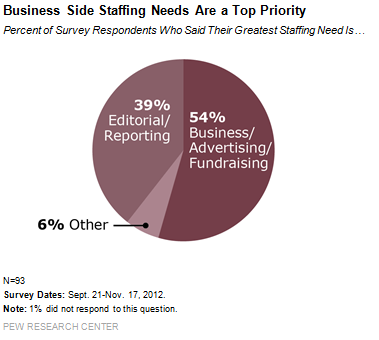
New report provides a lens into a “fragile” nonprofit news industry
Above: Data from a new Pew Research Center report, “Nonprofit Journalism: A Growing but Fragile Part of the U.S. News System.”
The question of sustainability comes up a lot when considering the nonprofit news industry. While quality of reporting, or an extensive network of professionals may help organizations build a following—it’s really about the business model. Most people aren’t debating that the work of nonprofit news organizations is smart and relevant. The fundamental question is how to keep them afloat.
In October 2011, Knight published “Getting Local: How Nonprofit News Ventures Seek Sustainability.” We featured a handful of nonprofit news organizations and explored their business strategy, economic viability and adaptability—all components of long-term sustainability. Two years later, we’re still wrestling with the same question: How can we strengthen and protect informed communities and local information ecosystems, including nonprofit news organizations?
A new report released today by the Pew Research Center’s Project for Excellence in Journalism, “Nonprofit Journalism: A Growing but Fragile Part of the U.S. News System,” surveyed almost 100 nonprofit news organizations to examine the current landscape. According to the report, there’s positive momentum in the nonprofit news community. People are feeling optimistic. For most organizations that shared 2011 financials, revenues exceeded expenses. For a fledgling industry, this is very good news. Eight in 10 respondents reported, “they were very or somewhat confident they’d be financially solvent five years down the road.”

However, the pervasive story is that many are facing challenges to their long-term financial health. For example, Pew reports that only 28 percent of the original funders have renewed their start-up funding. Currently, 75 percent of the nonprofit news organizations generate income from a single source of revenue, nearly all of which are foundation grants. So, what’s the viable back up plan? Pew tells us that in nearly one third of the nonprofits, business/advertising and marketing consumed less than 10 percent of their staff time. In effect, they are not developing the business-side resources they need to attract the alternate revenue streams that would ensure their financial future. Finding a path to sustainability will require a dedicated strategy. The good news is that most of the organizations surveyed are now acknowledging this gap—a majority, 54 percent, see business staffing needs as a top priority.
We hope to help them on their way by identifying new avenues for growth. We know from the FCC report on “The Information Needs of Communities,” that there are “real consequences of journalistic shortages.” So, like Pew, we continue to examine the challenge facing the nonprofit news industry. We’re now working on our follow-up report to “Getting Local.” We’ve expanded the group of nonprofit sites included in the research, and we’ve broadened the focus. This round we’ll dive deeper into social media strategies, and explore the use of mobile, video and data for many nonprofit news operations. We want to know if creative and new-media strategies can offer a way up.
We all want the news outlets we rely on to be healthy and vibrant. Perhaps the more we examine the underlying issues of sustainability facing this fragile industry, the better chance we have of finding the stability that will allow it to thrive.
By Kito Cetrulo, strategic assessment officer at Knight Foundation
Recent Content
-
Journalismarticle ·
-
Journalismarticle ·
-
Journalismarticle ·


